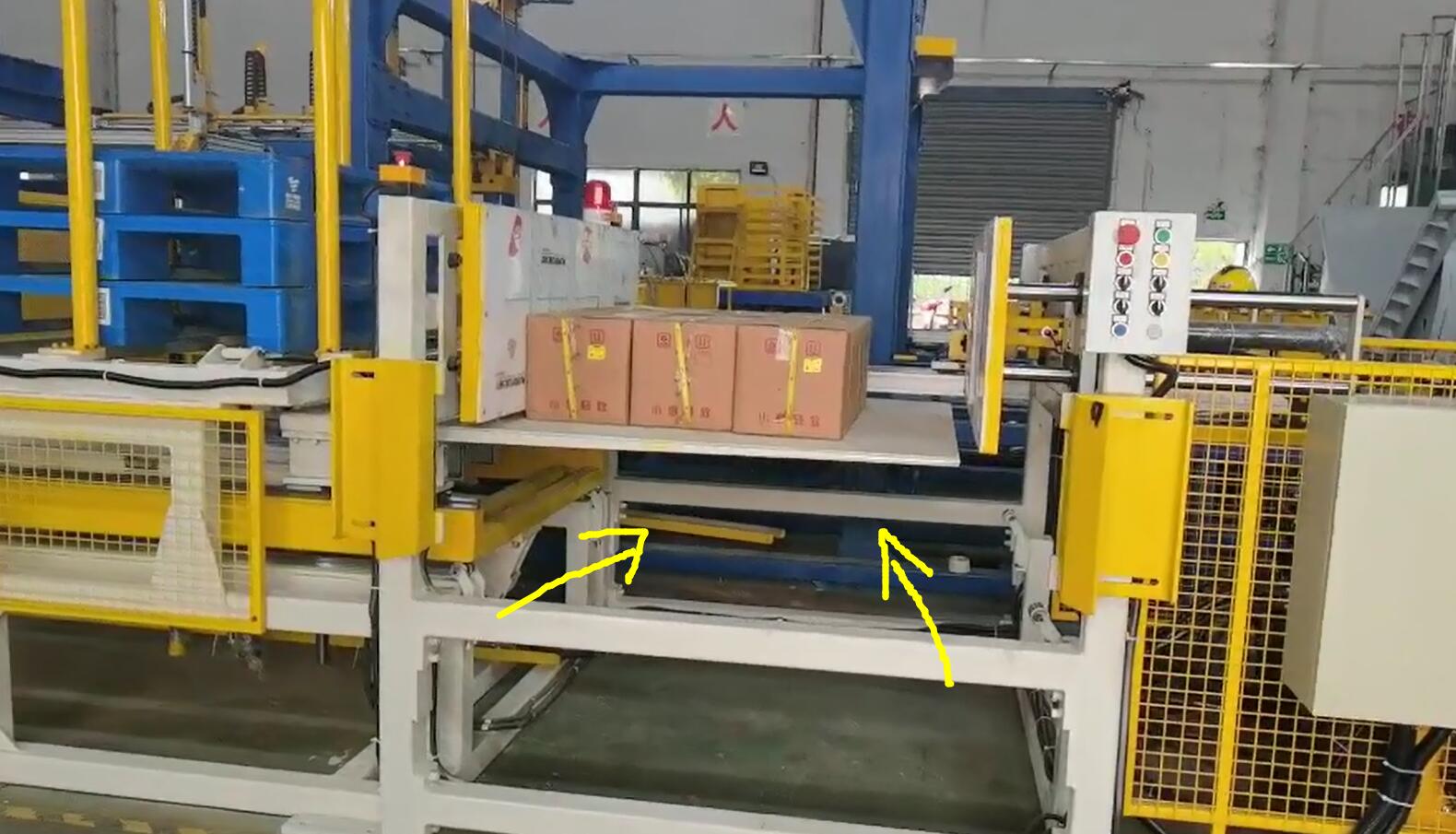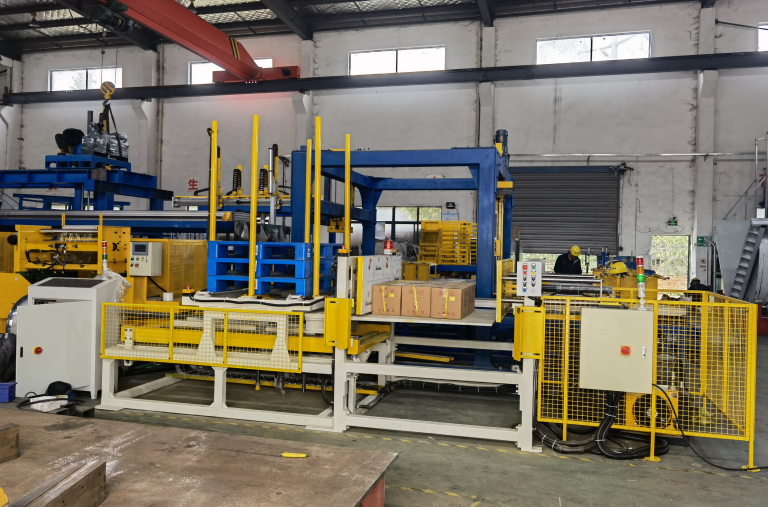1. Enhancing Supply Chain Integrity: The Strategic Role of Non-Inverting Pallet Changing Machines
In today's meticulously managed supply chains, particularly within demanding sectors like pharmaceuticals, food and beverage, and chemical processing, the requirements for operational hygiene, process efficiency, and unwavering load integrity are paramount. Effectively managing pallet variations—whether transitioning between wood and plastic, segregating internal versus external pallets, or preventing contaminant transfer—poses a considerable logistical hurdle. Advanced automated load transfer systems, specifically state-of-the-art non-inverting pallet changers, present a highly effective and technically robust solution to these challenges.
2. Decoding the Non-Inverting Pallet Changer: Functionality and Design
A non-inverting pallet changer, frequently referred to within the industry as a pallet exchange machine or an automated load transfer system, represents a specialized category of material handling equipment. Its core function is to seamlessly swap the pallet beneath a unitized load without resorting to tipping, rotating, or inverting the entire payload. This non-inverting capability is absolutely critical when dealing with loads that are inherently unstable, exceptionally fragile, or contain liquids, where any inversion could lead to costly product damage, spillage, or compromised packaging integrity. As detailed in numerous material handling technology patents focusing on sophisticated clamping and transfer mechanisms, these machines predominantly utilize precisely controlled side-clamping systems coupled with efficient push-pull technologies to execute the pallet exchange.

3. Operational Workflow and Tangible Advantages
The typical operational sequence of a non-inverting pallet changer involves several key stages:
- Load Infeed: The palletized load is accurately conveyed or manually placed into the designated machine loading bay.
- Secure Load Clamping: Advanced side walls or precisely adjustable pressure plates engage, gently securing the load from its sides. This system supports the full weight of the product stack independently of the original base pallet. Modern designs incorporate sophisticated pressure sensing and control algorithms to prevent any product compression or damage during this phase (referencing innovations like those discussed in US Patent Application Publication No. US 2018/0127211 A1 regarding load stabilization).
- Pallet Exchange Execution: The original pallet (e.g., a potentially contaminated wooden pallet from transport) is carefully lowered or withdrawn from beneath the suspended load. Simultaneously, the new target pallet (such as a sanitized plastic pallet or a standardized in-house captive pallet) is precisely positioned underneath.
- Controlled Load Release: The clamping pressure is gradually released, allowing the load to settle gently and securely onto the newly positioned pallet.
- Discharge Cycle: The re-palletized load, now on the desired pallet type, is efficiently discharged from the machine, ready for the next stage in the process (e.g., warehouse storage, cleanroom entry, production line feeding).
This refined non-inverting methodology delivers significant operational and strategic advantages, frequently highlighted in logistics optimization studies and packaging industry reports:
- Unyielding Load Integrity: Absolutely essential for vertically sensitive products (e.g., tall stacks), liquids in containers, glass vials, or loosely arranged items that cannot tolerate tilting or inversion.
- Superior Hygiene Control: Streamlines the critical process of replacing external/wood pallets with internal/plastic ones. This is fundamental for maintaining compliance with stringent GMP (Good Manufacturing Practice) and HACCP (Hazard Analysis Critical Control Point) standards prevalent in the food, beverage, and pharmaceutical sectors, as often emphasized in publications like Pharmaceutical Engineering and Food Safety Magazine.
- Boosted Operational Throughput: Automates what is traditionally a labor-intensive, time-consuming manual process. This drastically cuts down manual handling time, minimizes associated risks, and can achieve impressive cycle times, often under 60 seconds per pallet, significantly enhancing throughput at busy receiving docks or production line interfaces.
- Improved Workplace Ergonomics and Safety: Completely eliminates the need for hazardous manual lifting and restacking of heavy loads, directly reducing the risk of musculoskeletal injuries (MSIs) among staff and promoting better alignment with occupational safety guidelines (e.g., OSHA recommendations on safe material handling practices).
4. Technical Deep Dive: Design, Structure, and Key Components
Understanding the engineering behind these machines is crucial for selection and implementation:
4.1. Structural Design & Materials
- Frame: Typically constructed from heavy-duty welded steel (e.g., carbon steel with durable powder coating) for general industrial applications.
- Hygienic Options: For food, pharma, or corrosive environments, stainless steel construction (commonly grades 304 or 316L) is essential, often featuring smooth welds and hygienic design principles to meet standards like NSF/ANSI for food equipment.
4.2. Core Components
- Clamping System: This is the heart of the non-inverting process. Options include:
- Dual Side Plates: Most common, applying gentle, even pressure from both sides. Surfaces can be lined with non-marking materials (e.g., rubber, specialized polymers) for delicate loads.
- Top Pressure Plate (Optional): Used for stabilizing very tall or light loads during the exchange.
- Pressure Control: Utilizes hydraulic or electro-mechanical actuators with precise pressure regulation (often adjustable via HMI) to accommodate different load types and weights.
- Pallet Handling Mechanism: Systems for removing the old pallet and inserting the new one (e.g., push-pull mechanism, retractable conveyor sections, lifting platform).
- Drive System: Typically employs reliable electric motors for conveyor movements and either hydraulic power units or electric actuators for the clamping and lifting functions, chosen based on required force, speed, and environmental considerations.
- Control System: Centralized control using a Programmable Logic Controller (PLC) (e.g., Siemens, Allen-Bradley) integrated with a user-friendly Human-Machine Interface (HMI) touch screen for operation, diagnostics, parameter adjustments (like clamping pressure, cycle speed), and fault finding.
- Safety Features: Comprehensive safety systems are non-negotiable and must comply with relevant standards (e.g., ISO 13849-1, ANSI/RIA R15.06). These typically include:
- Safety light curtains guarding entry/exit points.
- Physical safety fencing with interlocked access gates.
- Emergency stop buttons at key operator locations.
- Load presence sensors and anti-collision logic.
4.3. Technical Data Comparison (Typical Ranges)
| Parameter | Typical Range / Options | Importance |
|---|---|---|
| Load Capacity | 1,000 kg - 2,500 kg (2,200 - 5,500 lbs) | Must exceed maximum anticipated load weight. |
| Cycle Time | 30 - 90 seconds (load dependent) | Directly impacts throughput and line efficiency. |
| Pallet Compatibility | GMA, EURO, CHEP, UK Pool, Plastic (various) | Needs to handle all required incoming/outgoing types. |
| Max Load Height | Up to 2,400 mm (94 inches) or higher | Must accommodate tallest expected loads. |
| Clamping Pressure | Adjustable (e.g., 5 - 20 PSI) via HMI | Crucial for handling delicate items safely. |
| Construction | Painted Carbon Steel / Stainless Steel (304/316L) | Dictated by operating environment (hygiene). |
| Power Requirements | 480V/3Ph/60Hz (US) or 400V/3Ph/50Hz (EU) | Must match facility power supply. |
| Control System | PLC (Siemens, Allen-Bradley) + HMI | Ease of use, integration, and maintenance. |
5. Broad Industry Applicability and Integration Pathways
Non-inverting pallet changers deliver value across a wide spectrum of industries:
- Pharmaceuticals & Nutraceuticals: Critical for maintaining validated cleanroom environments by swapping external delivery pallets for sanitized internal ones before goods enter controlled zones. Prevents particulate and microbial contamination.
- Food & Beverage Processing: Essential for preventing cross-contamination risks associated with wood pallets (splinters, bacteria, allergens) and meeting stringent retailer mandates for specific pallet types (e.g., CHEP, PECO, plastic hygiene pallets).
- Chemical Manufacturing & Handling: Safely manages pallet exchanges for bagged goods, drums, or Intermediate Bulk Containers (IBCs) containing sensitive or potentially hazardous materials that cannot be tilted.
- Cosmetics and Personal Care: Ensures product integrity and prevents contamination during pallet swaps in clean production environments.
- Electronics Manufacturing: Protects sensitive electronic components and assemblies from potential shock or vibration damage associated with inversion methods during pallet standardization.
- General Warehousing & Distribution Centers: Streamlines operations by managing diverse incoming pallet quality, standardizing loads onto uniform internal or outgoing pallets, reclaiming valuable warehouse space by efficiently removing unwanted pallets, and improving dock-to-stock times.
These machines offer flexibility, capable of operating as standalone units serviced by forklifts or AGVs, or being fully integrated into automated warehouse systems, linking seamlessly with roller or chain conveyors, sortation systems, and Warehouse Management Systems (WMS) for end-to-end automation.
6. User Experience & Implementation Considerations
From a user and operational perspective, successful implementation hinges on several factors:
- Ease of Use: Modern HMIs provide intuitive controls, allowing operators to select pre-programmed recipes for different load types and pallet sizes with minimal training. Clear diagnostic messages simplify troubleshooting.
- Footprint & Layout: Adequate floor space is required not just for the machine itself, but also for queuing incoming/outgoing loads and potential maintenance access. Integration requires careful planning of conveyor layouts and traffic flow.
- Maintenance: While robustly built, regular preventative maintenance (lubrication, sensor checks, hydraulic system inspection if applicable) is vital for long-term reliability. Access for maintenance should be considered during installation.
- Customization: Reputable suppliers offer customization options to handle non-standard pallet sizes, exceptionally heavy or tall loads, or specific environmental requirements (e.g., explosion-proof ratings, washdown capabilities).
- Operator Training: While operation is often simple, proper training on safety procedures, basic operation, fault recovery, and cleaning protocols (especially in hygienic applications) is essential.
7. Conclusion: A Strategic Investment in Future-Proof Logistics
The non-inverting pallet changing machine is far more than just material handling equipment; it represents a strategic investment in operational excellence. By facilitating rapid, secure, and contamination-free pallet exchanges without compromising the stability or integrity of the load, it directly confronts and resolves critical modern challenges in supply chain efficiency, stringent regulatory compliance, and workplace safety. For organizations operating within demanding regulatory frameworks or handling sensitive products, adopting this advanced technology is a decisive step towards optimizing logistical workflows, guaranteeing product quality, enhancing worker safety, and upholding the highest standards of operational and hygienic integrity demanded by today's competitive global marketplace.


